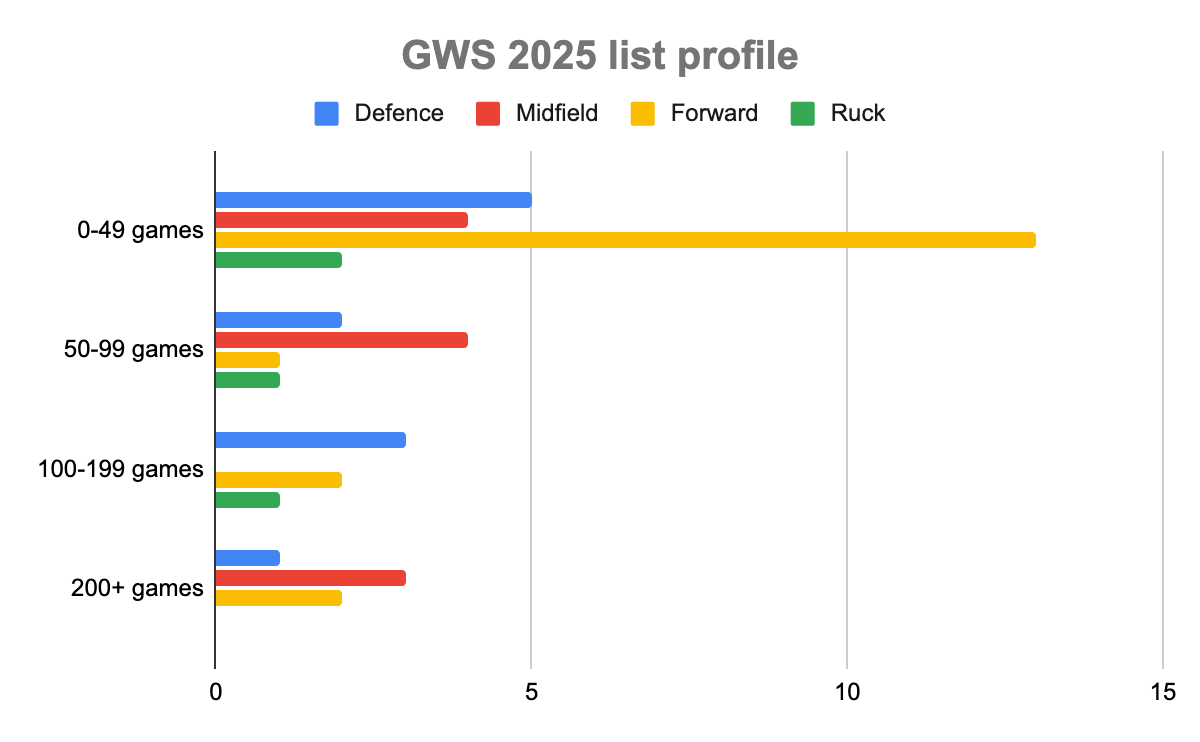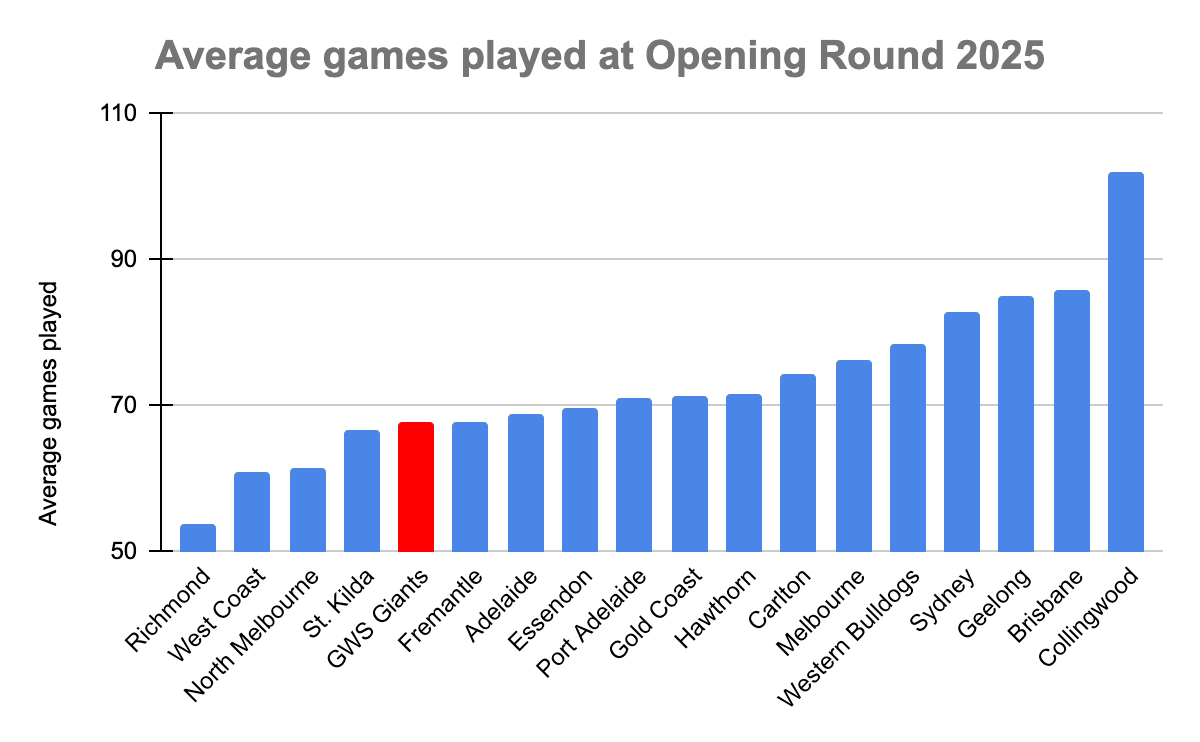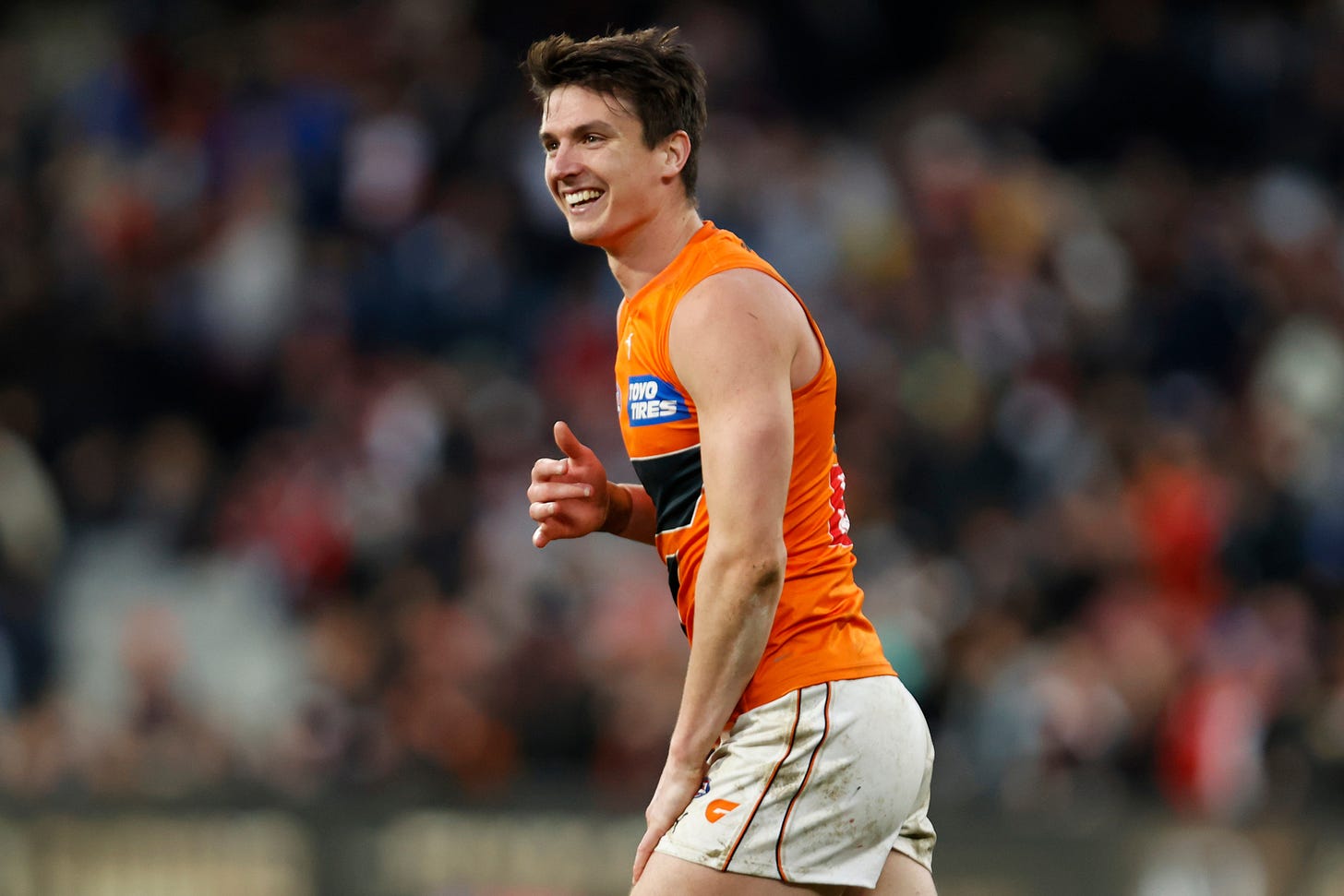2025 AFL Season Previews: Greater Western Sydney
What if we built the whole team out of small forwards?
Preview number nine asks: how big will the sound coming from the west of the town be?
2024 ladder position: 4th (15 wins, 8 losses – eliminated at Semi-Final stage)
2024 best-and-fairest: Jesse Hogan
Senior coach: Adam Kingsley
Story of the season
Like one of those films where everyone dies at the end. The Giants, many people’s Premiership fancies raced out to a 5-0 start which, in hindsight, papered over some cracks. A couple of reasonably close defeats either side of a demolition of Brisbane at home – an amazing set-up for the final twist – didn’t raise any flags, orange or otherwise, among anyone except perhaps some analytics nerds. Adam Kingsley’s side reeled off seven straight wins in the final third of the season, including heart-stoppers against Melbourne and Hawthorn in consecutive weeks, to secure a top-four spot and the double chance. Things started going wrong approximately 23 minutes into the second quarter of the qualifying final against Sydney. There’s going out in straight sets. And then there’s going out in straight sets against the two eventual Grand Finalists when you were dominating both games. Two sickening blows put paid to a season which had held such rich promise. The pain wasn’t quite over yet. A costume-related snafu at their end-of-season function resulted in the suspension of multiple young players and one last dollop of despair for Giants fans.
Summary of game style
The phrase Orange Tsunami may have fallen out of vogue, but – despite some subtle tweaks – it’s still applicable to how the Giants play. When attacking, GWS prefer to move it quickly by hand (they ranked first for handballs and 18th for kicks as a share of disposals) in order to create space and overloads in attacking positions. If the Orange Tsunami of 2023 was the brash debut, then its 2024 form was the mature, sophisticated-sounding second album. The Giants moved the ball slightly more slowly in attack and responded to improved opposition pressing schemes by shifting it wider in order to maximise the size of the field. But the result is still frequently exhilarating – if it was easy to get forward handball receives stats, I’m sure Kingsley’s side would figure prominently.
It’s also risky, and the Giants need a few key elements to make it viable. The first is their foot speed. GWS have absolutely loads of little fast guys. The second is the quality of their key defenders, who are unusually comfortable in one-on-one situations. And the third is their high half-forwards. The likes of Toby Greene, Brent Daniels and Darcy Jones are heavily involved in all phases of play. At stoppages, they’ll often sit just outside of the contest and either make themselves available for handball receives or disrupt the opposition doing the same. They’re also active in transition, helping to force turnovers when GWS are defending and often serving as either final or penultimate link in attacking chains. The fact that the Giants were the second-best side at keeping the ball inside their forward 50 is a testament to the quality of their half-forwards, as well as Jesse Hogan’s contested ability.
Defensively, the Giants look to create turnovers at ground level instead of in the air. They ranked first for tackles and third for defensive pressure acts, but only 16th for intercept marks. Partly that’s down to having lots of small guys, and partly that’s a choice. The way the Giants attack means the players that would normally drift back to intercept can often get lost in defensive transition. As a result, the Giants ranked first for defensive one-on-ones while simultaneously giving up the most contested marks and the highest share of opposition marks inside 50.
List changes
In:
Oliver Hannaford (2024 National Draft, pick #18)
Harrison Oliver (2024 National Draft, pick #19)
Cody Angove (2024 National Draft, pick #24)
Jack Ough (2024 National Draft, pick #36)
Logan Smith (2024 National Draft, pick #71 – Academy)
Josaia Delana (Category B Rookie)
Jake Stringer (trade – Essendon)
Out:
Cooper Hamilton (delisted)
Braydon Preuss (delisted)
Adam Kennedy (retired)
James Peatling (trade – Adelaide)
Isaac Cumming (free agent – Adelaide)
Nick Haynes (free agent – Carlton)
Harry Perryman (free agent – Collingwood)
List profile
Number of top-10 draft picks: eight (T-4th)
Average age at Opening Round: 24.2 (13th)
Average number of games played: 66.7 (14th)
The Giants were already a young side, and they became younger and less experienced after Nick Haynes, James Peatling, Isaac Cumming and Harry Perryman walked out the door. Based on the quality of their recent drafting and development, you can make the case that the Giants will be better off in the long-term due to those departures. But, based on what we know right now, it’s difficult to mount a convincing argument that they’ll be stronger in in 2025.
You might want to be sitting down for this, but… GWS drafted some small forwards. The first was Oliver Hannaford. One of my favourite players from last year’s draft crop, the young Victorian impressed across half-forward and, later in the season, in midfield. He was one of the draft’s biggest bolters. The similarly-named Harrison Oliver was taken with the very next pick and will probably develop in time to take over from Lachie Whitfield as he begins ageing out. Cody Angove was regarded as a surprise, although from reading a description like “nifty smaller type with neat skills and a clean set of heels”, I wonder why there was any surprise whatsoever. Jack Ough is a tall midfielder who will probably start on a wing but has the potential to move inside as his body matures.
Where does that leave the defence, midfield, and forward lines? The Giants’ key position defensive stocks are very dependent on the health of Sam Taylor. Despite his athletic traits, Leek Aleer doesn’t (yet) offer anywhere near the same quality of defensive positioning and disposal. Jack Buckley, Connor Idun and Harry Himmelberg are very good auxiliary talls. Lachie Whitfield is a gifted back-half distributor, although I worry that he carries too much of the burden for the Giants’ ball movement from the back half.
The midfield is the line which has been most adversely affected by the summer mini-exodus. Tom Green is now the clear leader of the midfield and will attend almost every single centre bounce he can. Finn Callaghan, who’s been eased into the on-ball rotation after beginning his career mainly on the outside, will feature more prominently. Coniglio will still be a mainstay, although given his age and recent injury troubles, I wouldn’t be surprised if his attendances are gradually dialled down. Adam Kingsley has shown he likes Toby Bedford’s accountability as a tagger or a midfielder who guards opposition stoppage exits. And after that, it’s a bit of a mystery. Expect Jake Stringer, Josh Kelly and perhaps even Darcy Jones, Toby Greene and Brent Daniels to get some reps. From the outside, it does look rather as though there’s a James Peatling-shaped hole.
The forward line is the main attraction. Toby Greene was down on his sparkling best in 2024 but remained a threat, while Brent Daniels had a career best season which was rewarded with a spot in the extended All-Australian squad. Darcy Jones has looked absolutely outstanding in his 14 games of senior football and his extreme speed makes the Giants a frightening prospect on transition. I suspect that trio will begin the season as the first-choice half-forward group, although the likes of Harvey Thomas and Toby McMullin will play plenty of senior footy. Jesse Hogan clunked everything which came his way last year – seeing him win his Coleman Medal at his third club was one of the most satisfying personal stories of the season. His gravity will create space for Aaron Cadman and Jake Stringer to work in. A fit and in-form Stringer will provide a genuine point of difference as an aggressive medium-forward with the ability to pinch hit in the midfield. His fit in a dangerous Giants forward line looms as one of the most interesting tactical micro-questions of the season (note to self: article idea). If the Giants’ forward line fires on all cylinders, they can go all the way.
Line rankings
Defence: Elite
Midfield: Average
Forward: Elite
Ruck: Above Average
The case for optimism
There are still more reasons for Giants fans to be positive than pessimistic. The first thing to say is that, despite offering useful depth and mature bodies, none of Peatling, Perryman, Cumming and Haynes were really moving the needle. Yes, the first three of those four were in the best 22. But they were more in the range of 10th-15th than true stars. It’s the form and fitness of Jesse Hogan, Toby Greene, Sam Taylor, Tom Green, Brent Daniels and Lachie Whitfield that’ll determine whether GWS can truly challenge in 2025. And, although I’m sure the Giants would have probably preferred to hold on to one of two of the departing quartet, they have reason to feel confident that the value of their contributions, or close to it, will be offset by the improvement of young players.
Which brings me neatly enough to my next point: the Giants are the youngest and least-experienced of the sides you could plausibly call flag contenders. That’s because they’ve managed to offset the retention challenges of being an expansion club in a relative footy backwater with years of excellent drafting. There are 18 players on the GWS list younger than 23. Most won’t become stars. But the early evidence suggests Finn Callaghan, Darcy Jones and Aaron Cadman have as good a chance as any players in the competition their age. The trio will play more prominent roles in 2025, as (presumably) will James Leake and Phoenix Gothard, the 2023 draftees who, due to injury and illness, still haven’t made their debuts. I think the GWS list will be weaker in 2025 than it was in 2024. But there’s good reason to believe that it’ll ultimately be stronger in 2026 and beyond – a period when this list should still be contending.
I think it’s also possible to say that, although the Giants have lost depth, they’ve gained quality in an area of greater need. They didn’t have a player like Jake Stringer before this season. And while one can question Stringer’s character and consistency, you can’t really question his quality. His power, in-between size, and ability to put in decent shifts at centre bounces will give the Giants a dimension they previously lacked. The lure of a flag might extract the best version of Stringer.
The final cause for optimism touches on the pain of those two finals defeats. It’s possible to say results slightly flattered the Giants last season (I expand on that in the next section). But I think it’s even easier to say that they really, really ought to have won one of those finals. Simulate their season from the 23-minute mark of the second quarter of the qualifying final 1,000 times, and the Giants play in a prelim at least 900 of those times. If they’d beaten Sydney, they’d have played a home prelim against Port Adelaide, a side they dispatched easily enough at home during the home & away season. Had they held on against Brisbane, they’d have faced Geelong, who they sensationally knocked off at GMHBA Stadium. I don’t mean to re-open old wounds. I just mean to say that, despite how much luck the Giants might have had in finishing in the top four, they were still very close to being there on the last Saturday of September.
The case for pessimism
The Giants have downgraded their list. And the spectacular end to their season somewhat obscured the fact that they were lucky to finish in the top four. I’ve already shared my thoughts about their list, so I'll use this space to discuss the numbers.
Only two sides conceded more inside-50s than the Giants did in 2024 – Richmond and North. Neither of those sides were great! Although creating turnovers in deep defensive positions and then burning opponents in transition is a cornerstone of the Giants’ game plan under Adam Kingsley, it’s still a dangerous game to play. The Giants bled territory because, despite the significant presence of Tom Green, they’re a poor stoppage side – ranking only 17th in clearance differential.
To underscore that, the Giants were ranked 11th for expected score differential (below St Kilda) and 13th for shots differential. The second of those is slightly discounted because, as a counter-attacking side, they were taking higher-percentage shots than all but four sides. Oh, and in addition to that, the Giants were also second for expected score +/- differential – essentially, they were the second-luckiest side when it came to their own shooting overperformance, compared to their opponents’ underperformance. As if to illustrate the practical consequences of that kind of variance, the Giants went 6-1 in home & away games decided by 12 points or fewer. The basic point is this: as unique as the Giants’ style is, and as likely as it is to generate some statistical oddities, that’s not the scoring profile of a flag contender.
It’s also probably time to start asking if we’ve seen the best of Toby Greene. He’s now the third-oldest player on the Giants’ list and his form dipped last season. The quality (and number, there’s dozens of them) of the small forwards on the Giants’ list makes this less of a concern than it would have been two years ago. But we’re still talking about someone who’s been in the top handful of AFL players for close to a decade. A player like Toby is hard to replace. Was 2024 the start of his decline, or just a blip? This year will make it clearer.
Enjoying this preview and think a Giants-supporting friend might too? Share it with them!
Breakout player
Last year, I nominated Aaron Cadman for a breakout year. And although he was definitely overshadowed by Jesse Hogan – anyone would have been – in the Giants forward line, he showed enough to make supporters of the Orange Team confident he’ll become a very, very good player. Expect him to go to the next level this year, along with Darcy Jones and Finn Callaghan.
Most important player
Sam Taylor is in the top handful of key position defenders in the entire competition and, along with Jesse Hogan up the other end, one of the major reasons the Giants can play their carefree footy. You only need to consider the deterioration in their ability to prevent opposition scores without him in the side. In the 18 games that Taylor played in 2024, the Giants conceded an average of 79.7 expected points per game. In the seven games he missed, his side conceded 92.6 expected points per game – more than two goals worse off.
Biggest question to answer
How will GWS cope with a loss of depth across their list? Although none of Peatling, Cumming or Perryman were in their best five players, nor probably even in their top 10, all provided useful versatility and at least competition-average performance in their position. At the time of writing, it’s believed that the Giants could debut as many as three players in their opening game (partly due to the suspensions handed down to the younger players following the end-of-season function unpleasantness). Great! Except if you’re a team that believes it’s competing for the Premiership, then it’s not as great.
What success looks like
The decision to bring in Jake Stringer suggests the Giants hierarchy believes this current list can win the club’s maiden Premiership. That’s an unreasonably high standard for success. However, judged against those ambitions, anything less than a top-four finish and a prelim will feel disappointing.
In a nutshell
The Giants are still quick and bold and talented. They’re also shallow in some key spots, and probably won’t have the same luck as they enjoyed for most of 2024. Don’t be surprised if they slide, at least a little.
Agree? Think I’m a fool who’s biased against the Giants? Share your thoughts in the comments.






